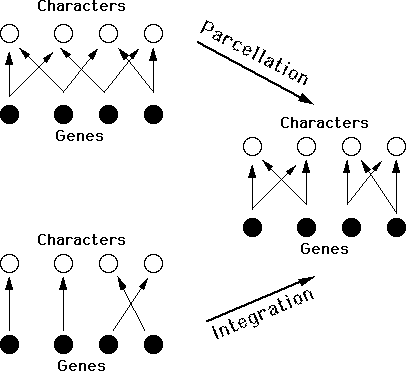
| "One may wonder, [...] how complex organisms evolve at all. They seem to have so many genes, so many multiple or pleiotropic effects of any one gene, so many possibilities for lethal mutations in early development, and all sorts of problems due to their long development." — J. T. Bonner, 1988, p. 173. |

The problem of complex adaptations is studied in two largely disconnected research traditions: evolutionary biology and evolutionary computer science. This paper summarizes the results from both areas and compares their implications. In evolutionary computer science it was found that the Darwinian process of mutation, recombination and selection is not universally effective in improving complex systems like computer programs or chip designs. For adaptation to occur, these systems must possess "evolvability", i.e. the ability of random variations to sometimes produce improvement. It was found that evolvability critically depends on the way genetic variation maps onto phenotypic variation, an issue known as the representation problem. The genotype-phenotype map determines the variability of characters, which is the propensity to vary. Variability needs to be distinguished from variation, which are the actually realized differences between individuals. The genotype-phenotype map is the common theme underlying such varied biological phenomena as genetic canalization, developmental constraints, biological versatility, developmental dissociability, morphological integration, and many more. For evolutionary biology the representation problem has important implications: how is it that extant species acquired a genotype-phenotype map which allows improvement by mutation and selection? Is the genotype-phenotype map able to change in evolution? What are the selective forces, if any, that shape the genotype-phenotype map? We propose that the genotype-phenotype map can evolve by two main routes: epistatic mutations, or the creation of new genes. A common result for organismic design is modularity. By modularity we mean a genotype-phenotype map in which there are few pleiotropic effects among characters serving different functions, with pleiotropic effects falling mainly among characters that are part of a single functional complex. Such a design is expected to improve evolvability by limiting the interference between the adaptation of different functions. Several population genetic models are reviewed that are intended to explain the evolutionary origin of a modular design. While our current knowledge is insufficient to assess the plausibility of these models, they form the beginning of a framework for understanding the evolution of the genotype-phenotype map.
“Wagner and Altenberg moved significantly from this ‘classical’ concept of evolvability with their groundbreaking articulation of the distinction between variation and variability as determining evolvability.”
... “the Wagner and Altenberg paper has unleashed a barrage of new definitions of evolvability, most of which turn out to be variations of Wagner and Altenberg’ s own proposal.”
“The large middle ground of concepts (of the Wagner and Altenberg type) can be seen as a necessary building block of the EES [Extended Evolutionary Synthesis].”— Pigliucci, M., 2008. Is evolvability evolvable? Nature Reviews Genetics, 9(1), p.75.
“W&A’96 was key in establishing disciplinary connections that will turn evolvability into a transdisciplinary research topic. In the 1990s, there were two disconnected clusters on evolvability, one on evolutionary computation and another one on quantitative genetics. The publication of W&A’96 was a fundamental intellectual turning point, insofar as it played a pivot role in connecting these two clusters. On the one hand, W&A’96 connected evolutionary biology and evolutionary computation through the problem of complex adaptations: in order to evolve, complex systems (computer programs or organisms) must be able to do so, that is, to possess the ability to generate random variations that sufficiently often produce improvement. On the other hand, W&A’96 argues for the need for describing the variability of traits and its evolution in population genetic terms. In this sense, W&A’96 emerges as the founding paper in introducing a developmental approach to evolvability into population genetics.”
“The relationship between modularity and evolvability in the framework of pleiotropy, the phenomenon of a single gene affecting multiple traits, was established in W&A’96.”— Nuño de la Rosa, L., 2017. Computing the Extended Synthesis: Mapping the Dynamics and Conceptual Structure of the Evolvability Research Front. Journal of Experimental Zoology Part B: Molecular and Developmental Evolution, 328(5), pp.395-411.
“In a pioneering discussion, Wagner and Altenberg (1996) identified a number of conditions on the G-P [genotype-phenotype] map that are necessary for evolvability, which incorporate but go beyond Lewontin’s quasi-independence.”—Okasha, S., 2018. The strategy of endogenization in evolutionary biology. Synthese, pp.1-23.